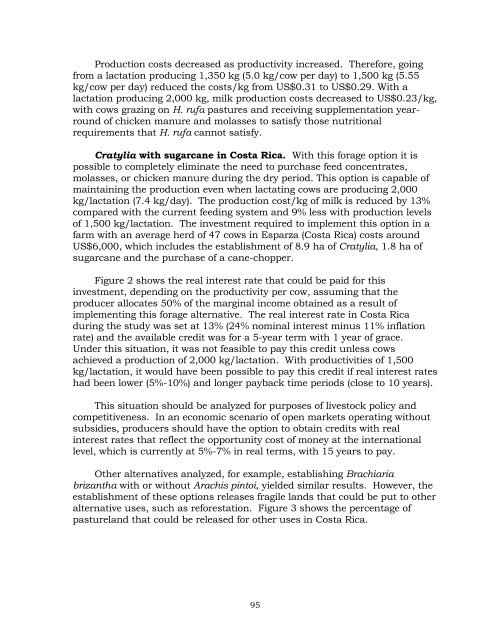Feeding Systems with Legumes to Intensify Dairy Farms - cgiar
Feeding Systems with Legumes to Intensify Dairy Farms - cgiar
Feeding Systems with Legumes to Intensify Dairy Farms - cgiar
Create successful ePaper yourself
Turn your PDF publications into a flip-book with our unique Google optimized e-Paper software.
Production costs decreased as productivity increased. Therefore, going<br />
from a lactation producing 1,350 kg (5.0 kg/cow per day) <strong>to</strong> 1,500 kg (5.55<br />
kg/cow per day) reduced the costs/kg from US$0.31 <strong>to</strong> US$0.29. With a<br />
lactation producing 2,000 kg, milk production costs decreased <strong>to</strong> US$0.23/kg,<br />
<strong>with</strong> cows grazing on H. rufa pastures and receiving supplementation yearround<br />
of chicken manure and molasses <strong>to</strong> satisfy those nutritional<br />
requirements that H. rufa cannot satisfy.<br />
Cratylia <strong>with</strong> sugarcane in Costa Rica. With this forage option it is<br />
possible <strong>to</strong> completely eliminate the need <strong>to</strong> purchase feed concentrates,<br />
molasses, or chicken manure during the dry period. This option is capable of<br />
maintaining the production even when lactating cows are producing 2,000<br />
kg/lactation (7.4 kg/day). The production cost/kg of milk is reduced by 13%<br />
compared <strong>with</strong> the current feeding system and 9% less <strong>with</strong> production levels<br />
of 1,500 kg/lactation. The investment required <strong>to</strong> implement this option in a<br />
farm <strong>with</strong> an average herd of 47 cows in Esparza (Costa Rica) costs around<br />
US$6,000, which includes the establishment of 8.9 ha of Cratylia, 1.8 ha of<br />
sugarcane and the purchase of a cane-chopper.<br />
Figure 2 shows the real interest rate that could be paid for this<br />
investment, depending on the productivity per cow, assuming that the<br />
producer allocates 50% of the marginal income obtained as a result of<br />
implementing this forage alternative. The real interest rate in Costa Rica<br />
during the study was set at 13% (24% nominal interest minus 11% inflation<br />
rate) and the available credit was for a 5-year term <strong>with</strong> 1 year of grace.<br />
Under this situation, it was not feasible <strong>to</strong> pay this credit unless cows<br />
achieved a production of 2,000 kg/lactation. With productivities of 1,500<br />
kg/lactation, it would have been possible <strong>to</strong> pay this credit if real interest rates<br />
had been lower (5%-10%) and longer payback time periods (close <strong>to</strong> 10 years).<br />
This situation should be analyzed for purposes of lives<strong>to</strong>ck policy and<br />
competitiveness. In an economic scenario of open markets operating <strong>with</strong>out<br />
subsidies, producers should have the option <strong>to</strong> obtain credits <strong>with</strong> real<br />
interest rates that reflect the opportunity cost of money at the international<br />
level, which is currently at 5%-7% in real terms, <strong>with</strong> 15 years <strong>to</strong> pay.<br />
Other alternatives analyzed, for example, establishing Brachiaria<br />
brizantha <strong>with</strong> or <strong>with</strong>out Arachis pin<strong>to</strong>i, yielded similar results. However, the<br />
establishment of these options releases fragile lands that could be put <strong>to</strong> other<br />
alternative uses, such as reforestation. Figure 3 shows the percentage of<br />
pastureland that could be released for other uses in Costa Rica.<br />
95
















